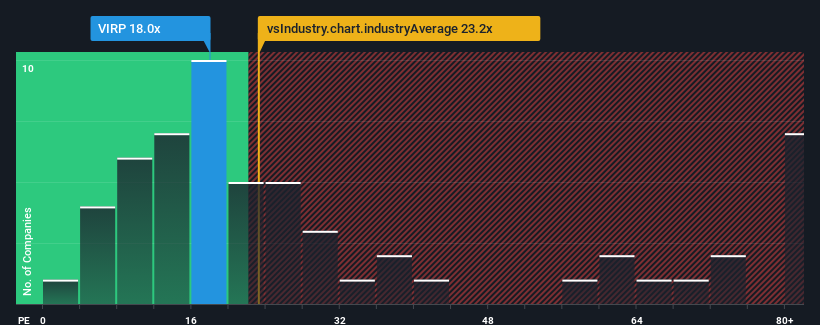Virbac SA (EPA:VIRP) Investors Are Less Pessimistic Than Expected
When close to half the companies in France have price-to-earnings ratios (or "P/E's") below 15x, you may consider Virbac SA (EPA:VIRP) as a stock to potentially avoid with its 18x P/E ratio. Nonetheless, we'd need to dig a little deeper to determine if there is a rational basis for the elevated P/E.
We check all companies for important risks. See what we found for Virbac in our free report.Recent times have been advantageous for Virbac as its earnings have been rising faster than most other companies. The P/E is probably high because investors think this strong earnings performance will continue. If not, then existing shareholders might be a little nervous about the viability of the share price.
Check out our latest analysis for Virbac

How Is Virbac's Growth Trending?
The only time you'd be truly comfortable seeing a P/E as high as Virbac's is when the company's growth is on track to outshine the market.
Retrospectively, the last year delivered an exceptional 20% gain to the company's bottom line. As a result, it also grew EPS by 29% in total over the last three years. Therefore, it's fair to say the earnings growth recently has been respectable for the company.
Looking ahead now, EPS is anticipated to climb by 10% per annum during the coming three years according to the seven analysts following the company. That's shaping up to be materially lower than the 13% per annum growth forecast for the broader market.
With this information, we find it concerning that Virbac is trading at a P/E higher than the market. It seems most investors are hoping for a turnaround in the company's business prospects, but the analyst cohort is not so confident this will happen. There's a good chance these shareholders are setting themselves up for future disappointment if the P/E falls to levels more in line with the growth outlook.
The Final Word
It's argued the price-to-earnings ratio is an inferior measure of value within certain industries, but it can be a powerful business sentiment indicator.
Our examination of Virbac's analyst forecasts revealed that its inferior earnings outlook isn't impacting its high P/E anywhere near as much as we would have predicted. When we see a weak earnings outlook with slower than market growth, we suspect the share price is at risk of declining, sending the high P/E lower. This places shareholders' investments at significant risk and potential investors in danger of paying an excessive premium.
A lot of potential risks can sit within a company's balance sheet. You can assess many of the main risks through our free balance sheet analysis for Virbac with six simple checks.
Of course, you might find a fantastic investment by looking at a few good candidates. So take a peek at this free list of companies with a strong growth track record, trading on a low P/E.
Have feedback on this article? Concerned about the content? Get in touch with us directly. Alternatively, email editorial-team (at) simplywallst.com.
This article by Simply Wall St is general in nature. We provide commentary based on historical data and analyst forecasts only using an unbiased methodology and our articles are not intended to be financial advice. It does not constitute a recommendation to buy or sell any stock, and does not take account of your objectives, or your financial situation. We aim to bring you long-term focused analysis driven by fundamental data. Note that our analysis may not factor in the latest price-sensitive company announcements or qualitative material. Simply Wall St has no position in any stocks mentioned.
 Wall Street Journal
Wall Street Journal